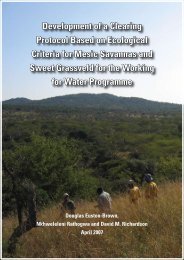Metsi Consultants - DWA Home Page
Metsi Consultants - DWA Home Page
Metsi Consultants - DWA Home Page
Create successful ePaper yourself
Turn your PDF publications into a flip-book with our unique Google optimized e-Paper software.
METSI CONSULTANTS: SUMMARY OF MAIN FINDINGS FOR PHASE 1 DEVELOPMENT<br />
ANNEX C. SUMMARY DESCRIPTION OF THE DRIFT METHOD<br />
DRIFT (Downstream Response to Imposed Flow Transformations) is explained in detail in Report No 648-F-03.<br />
Its major steps, as used in LHDA Contract 648, are outlined below.<br />
BIOPHYSICAL COMPONENTS OF THE PROCESS<br />
Preparing the Hydrological Data<br />
Step 1: For each IFR site, a representative 20-year data set of both present-day and historical daily flows were<br />
examined and the low and high flows separated by visual inspection.<br />
Step 2: In each data set, wet and dry low flow seasons were delineated.<br />
Step 3: Summary data were produced to describe the range of low flows in each of the seasons.<br />
Step 4: Annex C - High flows were allocated to size classes and summary statistics produced for each class.<br />
Linking the Hydrological Statistics to River Features<br />
Step 5: Low flow ranges were marked on cross-sectional diagrams at each site. These diagrams also showed<br />
information such as the location of zones of riparian vegetation and kinds of substrata. (see Figure<br />
C.1).<br />
Step 6: The highest level of each class of high flow was also marked on the graphics of the surveyed crosssections.<br />
Reducing Flow Levels and Recording the Biophysical Consequences<br />
Step 7: The reductions that could be made to the top end of the low flows with only minimal biophysical<br />
degradation of the ecosystem were described.<br />
Step 8: The predicted biophysical consequences of a further structured series of reductions to the top end of<br />
the low flows were described.<br />
Step 9: The contribution to river condition made by the high flows in each class was described.<br />
Step 10: Numbers of high flows in each class that could be harvested with minimal degradation to the<br />
ecosystem were identified.<br />
Step 11: The biophysical consequences of further reductions in high flow events were described.<br />
Step 12: All the consequences, each linked to its flow-reduction level, were entered into a database (Table C.1).<br />
Report No. 678-F-001 C-1

















